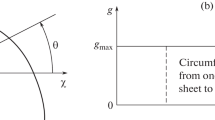Abstract
A numerical method is described for the calculation of the distributed and total aerodynamic characteristics of a thin wing of any planform. We use only the generally accepted hypotheses-smoothness of flow around the wing and the Chaplygin-Zhukovskii condition of finite velocity at the trailing edges. The medium is considered ideal and incompressible.
The development of a nonlinear theory for the wing of small aspect ratio in a compressible medium is one of the most important and difficult problems of wing theory. It has long attracted the attention of the aerodynamiscists. Chaplygin touched on this question in his 1913 report “On the vortex theory of the finite span wing”, presented to the Moscow Mathematical Society. Several interesting ideas and schemes were proposed by Golubev (see, for example, [2]). The first adequately correct and effective attempt to determine theoretically the nonlinear variation of wing normal force with angle of attack was that of Bollay [3]. In this work he studied rectangular wings of very small aspect ratio. The circulation variation law along the span was taken to be constant, and along the chord it was taken the same as for a flat plate of infinite span. It was also assumed that the centerlines of the free vortices trailing from the wing tips are straight lines and form the same angle with the plane of the wing. The magnitude of this angle was calculated from the average value of the relative velocity. The boundary condition at the wing was satisfied at a single point.
In several later studies [4–8] attempts have been made to extend this approach somewhat. In [7] the circulation variation law along the wing chord is calculated, and the boundary conditions are satisfied more exactly. However, attempts to convert to the study of wings of more complex planform, when the circulation can no longer be considered constant along the span, are hydrodynamically incorrect [5, 6, 8]. In these studies schemes are used in which with smooth flow around the wing the free vortices stand off from the wing surface. The angles which the vortex centerlines form with the wing surface are assumed or are calculated on the basis of very arbitrary hypotheses.
In the present paper the vortex layer which simulates the wing surface, just as in the linear theory [9, 10], is replaced by a system of discrete vortices. The free vortices away from the wing then are discrete curvilinear vortex filaments. Each of them is replaced by a series of rectilinear vortex segments. The number of bound and free discrete vortices may be increased without limit. The position of the free vortex segments is determined in the computation process, which is carried out sequentially for a series of angles of attack α, beginning with α→0 when the linear theory scheme holds. We note that the question of accounting for the effect of the leading-edge free vortex sheet is not considered here, although the method described may also be used to obtain results for this problem.
The proposed method turned out to be very general, flexible and convenient for the digital computer. It permits studying the practical convergence of the solution, and also permits obtaining not only the total and distributed characteristics of the wing of arbitrary planform, but also studying such delicate questions as the rollup of the vortex sheet behind the wing.
Similar content being viewed by others
References
“The work of S. A. Chaplygin on induced drag theory” [in French], PMM, vol. 5, no. 2, 1941.
V. V. Golubev, “On the theory of the small aspect ratio wing”, IAN SSSR, no. 3, 1947.
W. A. Bollay, A nonlinear wing theory and its application to rectangular wings of small aspect ratio”, Z. angew. Math. Mech., Bd. 19, Hft. 1, 1939.
N. N. Polyakhov and A. I. Pastukhov, “Theory of rectangular lifting surfaces”, Vestn. Leningr. un-ta, Matem., mekhan. i astron., no. 13, issue 3, 1959.
K. Gersten, Nichtlineare Tragflächentheorie insbesondere für Tragflügel mit kleinem Seitenverhaltnis. Ingenieur-Archiv, Bd. 30, Hft. 1, 1961.
H. Garner and D. Lehrian, Non-linear theory of Steady forces on wings with leading-edge flow separation,” ARC, R. and M., no. 3375, 1963.
S. D. Ermolenko, “Nonlinear theory of small aspect ratio wings”, Izv. VUZ. Aviatsionnaya tekhnika [Soviet Aeronautics], no. 2, 1966.
S. D. Ermolenko and A. V. Rovnykh, “On the nonlinear lifting surface theory”, Izv. VUZ. Aviatsionnaya tekhnika [Soviet Aeronautics], no. 2, 1967.
S. M. Belotserkovskii, The Thin Lifting Surface in Subsonic Gas Flow [in Russian], Nauka, Moscow, 1965.
S. M. Belotserkovskii, “Characteristics of the calculation of subsonic flow around wings of complex planform”, IAN SSSR, MZhG [Fluid Dynamics], no. 6, 1966.
Author information
Authors and Affiliations
Additional information
The author wishes to thank O. N. Sokolov and T. M. Muzychenko for the example calculations.
Rights and permissions
About this article
Cite this article
Belotserkovskii, S.M. Calculation of the flow around wings of arbitrary planform over a wide range of angles of attack. Fluid Dyn 3, 20–27 (1968). https://doi.org/10.1007/BF01019187
Issue Date:
DOI: https://doi.org/10.1007/BF01019187




